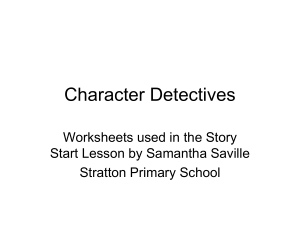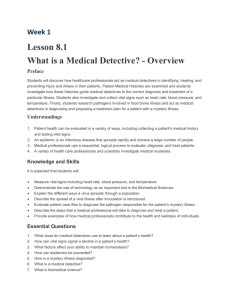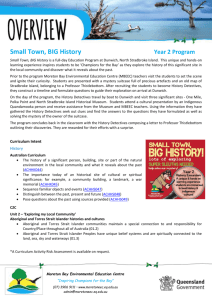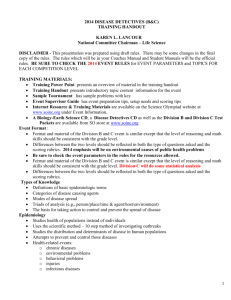Health Science Core PBL Critical Thinking 2012
advertisement
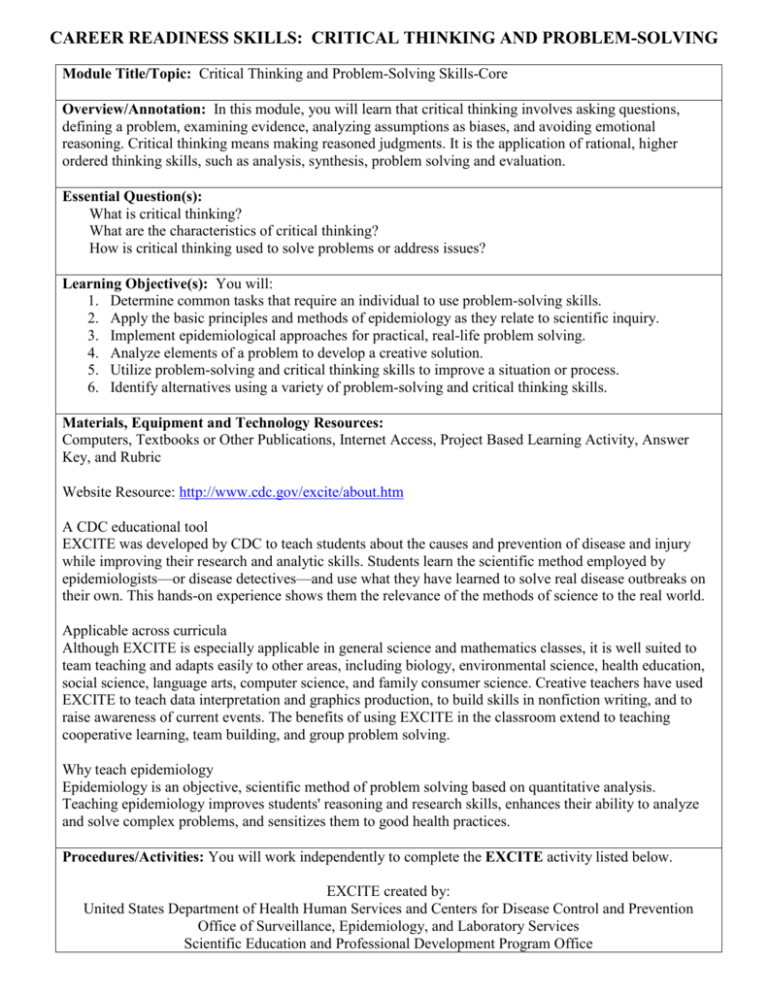
CAREER READINESS SKILLS: CRITICAL THINKING AND PROBLEM-SOLVING Module Title/Topic: Critical Thinking and Problem-Solving Skills-Core Overview/Annotation: In this module, you will learn that critical thinking involves asking questions, defining a problem, examining evidence, analyzing assumptions as biases, and avoiding emotional reasoning. Critical thinking means making reasoned judgments. It is the application of rational, higher ordered thinking skills, such as analysis, synthesis, problem solving and evaluation. Essential Question(s): What is critical thinking? What are the characteristics of critical thinking? How is critical thinking used to solve problems or address issues? Learning Objective(s): You will: 1. Determine common tasks that require an individual to use problem-solving skills. 2. Apply the basic principles and methods of epidemiology as they relate to scientific inquiry. 3. Implement epidemiological approaches for practical, real-life problem solving. 4. Analyze elements of a problem to develop a creative solution. 5. Utilize problem-solving and critical thinking skills to improve a situation or process. 6. Identify alternatives using a variety of problem-solving and critical thinking skills. Materials, Equipment and Technology Resources: Computers, Textbooks or Other Publications, Internet Access, Project Based Learning Activity, Answer Key, and Rubric Website Resource: http://www.cdc.gov/excite/about.htm A CDC educational tool EXCITE was developed by CDC to teach students about the causes and prevention of disease and injury while improving their research and analytic skills. Students learn the scientific method employed by epidemiologists—or disease detectives—and use what they have learned to solve real disease outbreaks on their own. This hands-on experience shows them the relevance of the methods of science to the real world. Applicable across curricula Although EXCITE is especially applicable in general science and mathematics classes, it is well suited to team teaching and adapts easily to other areas, including biology, environmental science, health education, social science, language arts, computer science, and family consumer science. Creative teachers have used EXCITE to teach data interpretation and graphics production, to build skills in nonfiction writing, and to raise awareness of current events. The benefits of using EXCITE in the classroom extend to teaching cooperative learning, team building, and group problem solving. Why teach epidemiology Epidemiology is an objective, scientific method of problem solving based on quantitative analysis. Teaching epidemiology improves students' reasoning and research skills, enhances their ability to analyze and solve complex problems, and sensitizes them to good health practices. Procedures/Activities: You will work independently to complete the EXCITE activity listed below. EXCITE created by: United States Department of Health Human Services and Centers for Disease Control and Prevention Office of Surveillance, Epidemiology, and Laboratory Services Scientific Education and Professional Development Program Office Student Activity Instructions: Read the topic introduction: Potential Health Hazards Associated with the Use of Cellular Telephones Complete the activity: Critical Thinking Problem Set o Read the information carefully regarding the investigation performed by epidemiologists o Research the questions utilizing the Internet o Create a Microsoft Word document stating the questions and your answers based on your research Print your work and give to instructor for grading based on criteria outlined in grading rubric Topic Introduction: Potential Health Hazards Associated with the Use of Cellular Telephones Hand-held cellular telephones have been used in the United States since 1984. By early 2001, the number of cell-phone users in the United States had exploded to more than 100 million, and to more than 500 million worldwide. Concerns about adverse health effects associated with cell-phone use have been raised, particularly their role in motor vehicle crashes and the incidence of certain cancers. Activity: Critical Thinking Problem Set Molecular ionization has been hypothesized as a cause of cellular mutations resulting in cancer. Previously, concerns have been raised about exposure to electromagnetic radiation from power lines. More recently, anecdotal reports have associated cell phone use with brain cancer; however, it has been noted that the energy in radio-frequency radiation may be insufficient to cause molecular ionization. Cell phones transmit and receive electromagnetic radiation at frequencies of about 1000 MHz. One of the first steps used by disease detectives in an investigation like this is to determine the study design that best investigates the hypothesis. 1. List two of the most common epidemiological study designs to investigate hypotheses of this sort. To investigate the hypothesized association of cell phone usage with brain cancer, disease detectives and other researchers studied patients in three hospitals. They found all patients (aged 18 years and older) with primary malignant brain tumors (i.e., the tumors originated in the brain and not elsewhere in the body) who had been admitted to these hospitals in Boston, Phoenix, and Pittsburgh between June 1994 and August 1998. In addition, the investigators chose a second group of patients admitted to the same hospitals during the same time period for conditions other than brain tumors. They excluded from this second group, any patients with tumors anywhere in their body. For each of the brain cancer patients studied, the investigators also chose a patient for the second group. 2. Why would the investigators use hospitals from different regions of the country? 3. In this investigation disease detectives developed a standard set of criteria for deciding whether a person should be included in the first group of patients. a. What is the term epidemiologist use for this standard set of criteria? b. List the criteria used in the study described above. The disease detectives asked study participants about cellular telephone use. They recorded calendar years of first and last use, duration of regular use (minutes per day), usual frequency of use (at least 2 calls per week), and which hand was usually used to hold the handset. In addition, they collected information on educational level, family income, type of health insurance coverage, history of medical exposure to ionizing radiation. Some patients in both groups were too ill or too functionally impaired to participate in the interview, or died before the interview could be completed. For these patients, information was obtained from other family members (proxies). The disease detectives enrolled 782 patients with primary brain tumors in the study and 799 patients without tumors. (Of this second group, 197 were admitted to the hospital for injuries.) Proxy interviews were necessary for 12% of the patients with brain tumors and 3% of the other group. Results from these interviews are given in Table 1 below. Table 1: Characteristics* of persons included in the investigation of cell phone use and brain cancer Characteristic† Brain Cancer No Brain Cancer Use of hand-held cell phone Ever used 308 358 Never used 471 440 >15 minutes 35 51 <15 minutes 103 117 Never/rarely 637 625 >500 hours 18 27 101 to 499 hours 34 27 13-100 hours 47 58 <13 hours 39 55 Never/rarely 637 625 Average daily use Cumulative use * Categories within each characteristic are mutually exclusive. Some characteristics were not measured for all study participants. † 4. Use the information/data above from the study to determine which characteristic(s) were most important in helping the disease detectives to investigate the possible association between cell phone use and brain cancer. You must show your work and include the appropriate measures of association in Table I. Then answer the following questions. a. What do these data and your calculations permit you to conclude about the association between cell phone use and brain cancer? b. Explain how you reached your conclusion. c. Name the type of study design the disease detectives used. d. What is the term that disease detectives use for the risk estimate you calculated? 5. Consider again the data from the study. The ability of these data to substantiate your conclusion may be affected by different kinds of misclassification of patients’ exposures. List two examples of causes of such misclassification. 6. Consider the data from this study, your calculations and conclusions, and your knowledge of cancer biology. Based on these considerations, what factors might be important in further studies? List two such factors. Assessment Strategies: 1. Critical Thinking Problem Set Rubric (Use Answer Key for Critical Thinking Problem Set Activity) 2. Evaluation of written and verbal presentation. Critical Thinking Problem Set Rubric Items Evaluated 1. List two of the most common epidemiological study designs to investigate hypotheses of this sort. 2. Why would the investigators use hospitals from different regions of the country? Points Possible 20 10 3. In this investigation disease detectives developed a standard set of criteria for deciding whether a person should be included in the first group of patients. a. What is the term epidemiologist use for this standard set of criteria? 5 b. List the criteria used in the study described above. 5 4. Use the information/data above from the study to determine which characteristic(s) were most important in helping the disease detectives to investigate the possible association between cell phone use and brain cancer. You must show your work and include the appropriate measures of association in Table I. Then answer the following questions in the space provided. 20 5 a. What do these data and your calculations permit you to conclude about the association between cell phone use and brain cancer? b. Explain how you reached your conclusion. c. Name the type of study design the disease detectives used. d. What is the term that disease detectives use for the 5 5 5 Points Earned risk estimate you calculated? 5. Consider again the data from the study. The ability of these data to substantiate your conclusion may be affected by different kinds of misclassification of patients’ exposures. List two examples of causes of such misclassification. 10 6. Consider the data from this study, your calculations and conclusions, and your knowledge of cancer biology. Based on these considerations, what factors might be important in further studies? List two such factors. 10 TOTAL POINTS 100 Instructor Answer Key: Critical Thinking Problem Set Activity 1. ecologic, cohort, cross-sectional, case control 2. To minimize study bias and increase generalizability of results. 3. Part (a) and part (b): a. Case definition b. A patient older than age 18, admitted between 1994 and 1998 to one of three participating hospitals with primary malignant brain tumor. 4. Consult Table 1 below. Table 1: Characteristics* of persons included in the investigation of cell phone use and brain cancer Characteristic† Brain Cancer No Brain Cancer Answer Odds Ratio Ever used 308 358 0.8 Never used 471 440 >15 minutes 35 51 0.7 <15 minutes 103 117 0.9 Never/rarely 637 625 >500 hours 18 27 0.7 101 to 499 hours 34 27 1.2 13-100 hours 47 58 0.8 <13 hours 39 55 0.7 Never/rarely 637 625 Use of hand-held cell phone Average daily use Cumulative use * Categories within each characteristic are mutually exclusive. Some characteristics were not measured for all study participants. † a. There is no evidence of a relation between exposure/use and risk of disease. Some students may conclude a protective effect in the absence of significance testing. b. Because this is a case/control study, we used an odds ratio to assess the risk between use of cell phones and occurrence of brain cancers. Calculations showed the odds ratios to be 1.0 or less, indicating no increased risk of brain cancers associated with use of cell phones. This problem required seven calculations of odds ratios, shown on the table above. For example, to calculate the risk associated with average daily use, one would first calculate odds of use more than 215 minutes compared to never/rarely: Odds ratio (associated with average daily use >=15 minutes) = ad/bc = (35) (625)/(51)(637) = 0.7. Odds ratio (associated with average daily use < 15 minutes) = ad/bc = (103) (625)/(117)(637) = 0.9. Clarifying note to students and teachers: it is important in stratified tables such as this that the calculation of odds ratio always use the referent category. In this instance, the referent category is "never/rarely" (i.e., the baseline of no exposure to cell phones). c. Case-control study d. Odds-ratio 5. Recall bias due to inability to capture historical patterns of use or memory impairment due to disease or time lapse. Ascertainment bias, because people who are more likely or less likely to use cell phones were differentially included in or excluded from the study (e.g., due to socioeconomic factors). Information bias, if investigators’ bias toward expected results influenced data collection. 6. Environmental: Long-term (induction periods use, changing phone technology. Behavior: changing patterns in use.
